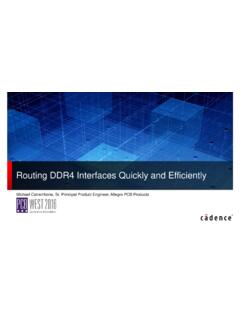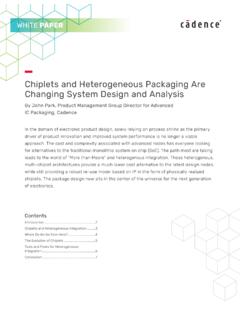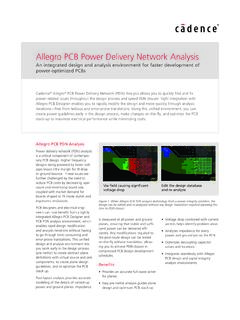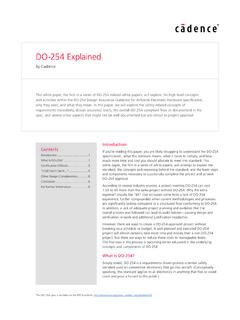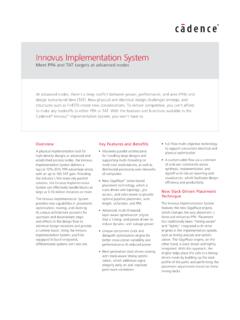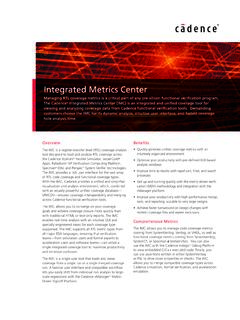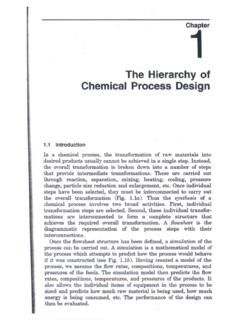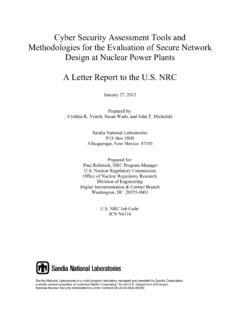Transcription of Holistic FMEDA-Driven Safety Design and Verification for ...
1 WHITE PAPER. Holistic FMEDA-Driven Safety Design and Verification for Analog, Digital, and Mixed-Signal Design By Robert Schweiger, Dominik Langen, and J rg M ller, Cadence With state-of-the-art electronics propelling the automotive industry into the future, automotive OEMs require Safety -certified semiconductors. The integration of these advanced technologies into cars drives a need for component suppliers to assess and audit the risk of the technologies they want to deploy. At the same time, Safety requirements are constantly evolving and becoming more stringent. To tackle these challenges, engineers are looking for a highly automated, integrated functional Safety solution to help them achieve ISO 26262 certification faster.
2 With Cadence's Failure Mode Effect and Diagnostic Analysis (FMEDA)-driven Safety Design and Verification solution, integrating analog/mixed-signal and digital applications allows customers to ensure their automotive semiconductors meet rigorous Safety standards while accelerating the ISO 26262 certification process . This white paper illustrates how to leverage the Cadence Midas Safety Platform as part of a integrated Safety flow to enable a FMEDA-Driven Safety methodology, including Safety Design , analysis and Verification for analog, digital and mixed-signal Design . Contents Hardware Architectural Safety The Safety FMEDA-Driven Safety Digital Functional and Safety Analog Safety Safety Conclusion and Holistic FMEDA-Driven Safety Design and Verification for Analog, Digital, and Mixed-Signal Design Introduction In recent years, Safety Design and Verification for digital circuits have made great progress.
3 However, more than 80% of field failures are due to the analog or mixed-signal portion of products [4]. Hence the Safety methodology must be enhanced to enable an integrated Safety flow for analog/mixed-signal and digital Design . According to the ISO 26262 standard, this flow should include a FMEDA to provide good estimations early in the Design cycle to guide the Safety Design and Verification . Safety cannot be an afterthought and must be addressed early on and at all stages of SoC development in Safety -critical verticals, such as automotive, health, and aerospace/defense. Good Safety practices start with a Safety architecture phase, which helps to define the Safety case and its requirements.
4 A quantitative FMEDA can be used during the concept phase to analyze the hardware Safety metrics using estimations for the area consumption of the different building blocks and for the effectiveness of the Safety measures. It's essential to identify failure modes of the hardware components and parts, calculate the probability of occurrence early in the Design cycle, and define appropriate Safety mechanisms to detect faults. Based on the predicted failure rates, the risk for a violation of a Safety goal can be determined early in the Design cycle and an appro- priate Safety architecture can be defined.
5 Avoiding later architectural changes is key because these are very time- and effort-consuming loops and, in many cases, it is impossible to fix Safety issues in later stages of the product development. However, since this approach starts with predicted failure rates, all numbers should be verified to avoid either overdesign of the Safety architecture or even worse underestimation of failure rates. Safety Verification (simulation or formal) is a much more accurate approach to determine the diagnostic coverage (DC) and calculate the hardware Safety metrics. The downside is that it is dependent on the availability of a hardware description, such as in RTL, gate-level, or transistors, and hence is deployed later in the SoC Design process .
6 Hardware Architectural Metrics The level of Safety one should strive to reach when planning a Safety -critical SoC varies depending on its functionality: a chip controlling air conditioning, for example, isn't nearly as important for the Safety of the vehicle than the system controlling the brakes. Safety Verification , as per the ISO 26262 standard, seeks to prevent two kinds of failures in automotive systems: f Systematic, where the failure is deterministic and inherent in the Design f Random, where the failure is not deterministic and could be caused by usage conditions This latter category contains both permanent faults, where a bit is stuck at one or zero, and transient faults, including single event upsets (SEUs) or other soft errors.
7 In the following paragraphs, we will focus on random failures. The ISO 26262 standard [7] defines four different automotive Safety integrity levels (ASIL) A, B, C, and D where ASIL D. represents the highest Safety level. Depending on the ASIL level, the hardware architectural metrics should be calculated and fulfilled, including single-point fault metric (SPFM), latent fault metric (LFM), and probabilistic metric for hardware failure (PMHF), as shown in Table 1. The failures-in-time (FIT) rate is determined by the number of random failures that can be expected in one billion (10 9) device-hours of operation.
8 The FIT rates for each Safety -related element add up for the overall system if not mitigated by Safety mechanisms. ASIL SPFM LFM PMHF. A Not relevant Not relevant < 1000 FIT. B 90% 60% < 100 FIT. C 97% 80% < 100 FIT. D 99% 90% < 10 FIT. Table 1: Target values for hardware architectural metrics for each ASIL. For more information on the basics of functional Safety methodologies for automotive applications and ASIL compliance, refer to [2]. 2. Holistic FMEDA-Driven Safety Design and Verification for Analog, Digital, and Mixed-Signal Design Safety Mechanisms Safety mechanisms are the features on a chip that detect and mitigate or make the Design tolerate faults and report them when faults have been detected.
9 In order to work properly, Safety mechanisms must be as reliable as possible, such as by keeping them inside a subsystem with an independent power and clock domain. This concept is referred to as a Safety island the physical area of a chip that is served by a given Safety mechanism that manages all Safety -related operations such as gathering of fault indication, fault management, and control of the system. However, Safety mechanisms can also stretch across multiple domains for example, a system-wide error correction code (ECC) protection works well over several domains and actually is intended to provide an uninterrupted chain of Safety mechanisms while data is transported.
10 A special case of a digital Safety mechanisms is a fault tolerant voting circuit driving a majority value decision of inputs to report a result. This is usually implemented as triple modular redundant system (TMR), which is more robust against data failures with increased fault coverage. Another class of common digital Safety mechanisms are ECCs to prevent bit errors. ECCs use redundancy in the transmitted data that can be used to recover the original message even if some bits are erroneously flipped. ECC, a subtype of cyclic redundancy check (CRC), assigns a checksum a given group of data that can be checked upon retrieval to ensure that no data corruption has occurred.

